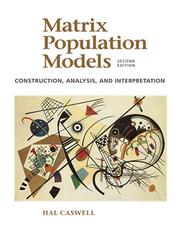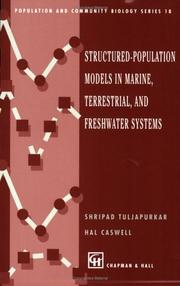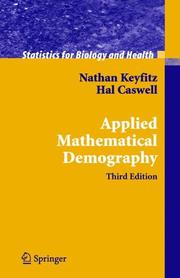| Listing 1 - 10 of 10 |
Sort by
|

ISBN: 9780878931217 Year: 2001 Publisher: Sunderland, Mass. Sinauer
Abstract | Keywords | Export | Availability | Bookmark
 Loading...
Loading...Choose an application
- Reference Manager
- EndNote
- RefWorks (Direct export to RefWorks)
Biomathematics. Biometry. Biostatistics --- Mathematical statistics --- Modèle --- Models --- Méthode statistique --- Statistical methods --- Traitement des données --- Data processing --- MET Methods & Techniques --- computer simulation --- demography --- life cycles --- mathematical methods --- matrix --- methods & techniques --- models --- population biology
Book
ISBN: 0878930930 0878930949 9780878930937 Year: 1989 Publisher: Sunderland (Mass.) : Sinauer associates,
Abstract | Keywords | Export | Availability | Bookmark
 Loading...
Loading...Choose an application
- Reference Manager
- EndNote
- RefWorks (Direct export to RefWorks)
Population biology --- Matrices --- Computer simulation. --- Data processing. --- 574.34 --- 681.3*I63 --- Population dynamics --- Applications (Simulation and modeling) --- MET Methods & Techniques --- computer simulation --- demography --- life cycles --- mathematical methods --- matrix --- methods & techniques --- models --- population biology --- 681.3*I63 Applications (Simulation and modeling) --- 574.34 Population dynamics --- Biology --- Ecology --- Data processing --- Computer simulation --- Population biology - Computer simulation. --- Matrices - Data processing.
Book
ISBN: 3030105342 3030105334 Year: 2019 Publisher: Cham Springer Nature
Abstract | Keywords | Export | Availability | Bookmark
 Loading...
Loading...Choose an application
- Reference Manager
- EndNote
- RefWorks (Direct export to RefWorks)
This open access book shows how to use sensitivity analysis in demography. It presents new methods for individuals, cohorts, and populations, with applications to humans, other animals, and plants. The analyses are based on matrix formulations of age-classified, stage-classified, and multistate population models. Methods are presented for linear and nonlinear, deterministic and stochastic, and time-invariant and time-varying cases. Readers will discover results on the sensitivity of statistics of longevity, life disparity, occupancy times, the net reproductive rate, and statistics of Markov chain models in demography. They will also see applications of sensitivity analysis to population growth rates, stable population structures, reproductive value, equilibria under immigration and nonlinearity, and population cycles. Individual stochasticity is a theme throughout, with a focus that goes beyond expected values to include variances in demographic outcomes. The calculations are easily and accurately implemented in matrix-oriented programming languages such as Matlab or R. Sensitivity analysis will help readers create models to predict the effect of future changes, to evaluate policy effects, and to identify possible evolutionary responses to the environment. Complete with many examples of the application, the book will be of interest to researchers and graduate students in human demography and population biology. The material will also appeal to those in mathematical biology and applied mathematics. .
Demography. --- Statistics. --- Ecology. --- Statistics for Social Sciences, Humanities, Law. --- Community & Population Ecology. --- Mathematical and Computational Biology. --- Balance of nature --- Biology --- Bionomics --- Ecological processes --- Ecological science --- Ecological sciences --- Environment --- Environmental biology --- Oecology --- Environmental sciences --- Population biology --- Statistical analysis --- Statistical data --- Statistical methods --- Statistical science --- Mathematics --- Econometrics --- Historical demography --- Social sciences --- Population --- Vital statistics --- Ecology --- Statistics . --- Community ecology, Biotic. --- Biomathematics. --- Biocenoses --- Biocoenoses --- Biogeoecology --- Biological communities --- Biomes --- Biotic community ecology --- Communities, Biotic --- Community ecology, Biotic --- Ecological communities --- Ecosystems --- Natural communities --- Demography --- Statistics --- Biomathematics
Digital
ISBN: 9783030105341 9783030105334 Year: 2019 Publisher: Cham Springer Open
Abstract | Keywords | Export | Availability | Bookmark
 Loading...
Loading...Choose an application
- Reference Manager
- EndNote
- RefWorks (Direct export to RefWorks)
This open access book shows how to use sensitivity analysis in demography. It presents new methods for individuals, cohorts, and populations, with applications to humans, other animals, and plants. The analyses are based on matrix formulations of age-classified, stage-classified, and multistate population models. Methods are presented for linear and nonlinear, deterministic and stochastic, and time-invariant and time-varying cases. Readers will discover results on the sensitivity of statistics of longevity, life disparity, occupancy times, the net reproductive rate, and statistics of Markov chain models in demography. They will also see applications of sensitivity analysis to population growth rates, stable population structures, reproductive value, equilibria under immigration and nonlinearity, and population cycles. Individual stochasticity is a theme throughout, with a focus that goes beyond expected values to include variances in demographic outcomes. The calculations are easily and accurately implemented in matrix-oriented programming languages such as Matlab or R. Sensitivity analysis will help readers create models to predict the effect of future changes, to evaluate policy effects, and to identify possible evolutionary responses to the environment. Complete with many examples of the application, the book will be of interest to researchers and graduate students in human demography and population biology. The material will also appeal to those in mathematical biology and applied mathematics. .
Demography --- Mathematical statistics --- Matlab (informatica) --- sociale ecologie --- biologie --- demografie --- informatica --- wetgeving --- statistiek --- ecologie --- wiskunde

ISBN: 0412072718 1461559731 Year: 1997 Publisher: New York, N.Y. Chapman & Hall
Abstract | Keywords | Export | Availability | Bookmark
 Loading...
Loading...Choose an application
- Reference Manager
- EndNote
- RefWorks (Direct export to RefWorks)
In the summer of 1993, twenty-six graduate and postdoctoral stu dents and fourteen lecturers converged on Cornell University for a summer school devoted to structured-population models. This school was one of a series to address concepts cutting across the traditional boundaries separating terrestrial, marine, and freshwa ter ecology. Earlier schools resulted in the books Patch Dynamics (S. A. Levin, T. M. Powell & J. H. Steele, eds., Springer-Verlag, Berlin, 1993) and Ecological Time Series (T. M. Powell & J. H. Steele, eds., Chapman and Hall, New York, 1995); a book on food webs is in preparation. Models of population structure (differences among individuals due to age, size, developmental stage, spatial location, or genotype) have an important place in studies of all three kinds of ecosystem. In choosing the participants and lecturers for the school, we se lected for diversity-biologists who knew some mathematics and mathematicians who knew some biology, field biologists sobered by encounters with messy data and theoreticians intoxicated by the elegance of the underlying mathematics, people concerned with long-term evolutionary problems and people concerned with the acute crises of conservation biology. For four weeks, these perspec tives swirled in discussions that started in the lecture hall and carried on into the sweltering Ithaca night. Diversity mayor may not increase stability, but it surely makes things interesting.
Models --- Aquatic communities --- Animal population --- plant population --- population dynamics --- population structure --- Biological competition --- Population distribution --- Daphnia --- Tribolium --- Applied Ecology. --- Mathematical and Computational Biology. --- Biomathematics. Biometry. Biostatistics --- General ecology and biosociology --- Population biology --- 574.3 --- 574.5 --- 591.526 --- 591.526 Population density of an animal species. Reproduction rate. Birth rate. Destruction rate. Death rate --- Population density of an animal species. Reproduction rate. Birth rate. Destruction rate. Death rate --- 574.3 Populations and environment. Population dynamics --- Populations and environment. Population dynamics --- 574.5 Hydrobiology. Aquatic biocoenoses and ecosystems. Food chains --- Hydrobiology. Aquatic biocoenoses and ecosystems. Food chains --- Mathematical models --- Applied ecology. --- Ecology . --- Evolutionary biology. --- Biomathematics. --- Ecology. --- Evolutionary Biology. --- Biology --- Mathematics --- Animal evolution --- Animals --- Biological evolution --- Darwinism --- Evolutionary biology --- Evolutionary science --- Origin of species --- Evolution --- Biological fitness --- Homoplasy --- Natural selection --- Phylogeny --- Balance of nature --- Bionomics --- Ecological processes --- Ecological science --- Ecological sciences --- Environment --- Environmental biology --- Oecology --- Environmental sciences --- Ecology --- Environmental protection --- Nature conservation --- Calathea ovandensis

ISBN: 9780387274096 0387225374 9781441919779 1441919775 038727409X Year: 2010 Publisher: New York, N.Y. Springer Science + Business Media
Abstract | Keywords | Export | Availability | Bookmark
 Loading...
Loading...Choose an application
- Reference Manager
- EndNote
- RefWorks (Direct export to RefWorks)
The third edition of this classic text maintains its focus on applications of demographic models, while extending its scope to matrix models for stage-classified populations. The authors first introduce the life table to describe age-specific mortality, and then use it to develop theory for stable populations and the rate of population increase. This theory is then revisited in the context of matrix models, for stage-classified as well as age-classified populations. Reproductive value and the stable equivalent population are introduced in both contexts, and Markov chain methods are presented to describe the movement of individuals through the life cycle. Applications of mathematical demography to population projection and forecasting, kinship, microdemography, heterogeneity, and multi-state models are considered. The new edition maintains and extends the book’s focus on the consequences of changes in the vital rates. Methods are presented for calculating the sensitivity and elasticity of population growth rate, life expectancy, stable stage distribution, and reproductive value, and for applying those results in comparative studies. Stage-classified models are important in both human demography and population ecology, and this edition features examples from both human and non-human populations. In short, this third edition enlarges considerably the scope and power of demography. It will be an essential resource for students and researchers in demography and in animal and plant population ecology. Nathan Keyfitz is Professor Emeritus of Sociology at Harvard University. After holding positions at Canada’s Dominion Bureau of Statistics, the University of Chicago, and the University of California at Berkeley, he became Andelot Professor of Sociology and Demography at Harvard in 1972. After retiring from Harvard, he became Director of the Population Program at the International Institute for Applied Systems Analysis (IIASA) in Vienna from 1983 to 1993. Keyfitz is a member of the U.S. National Academy of Sciences and the Royal Society of Canada, and a Fellow of the American Academy of Arts and Sciences. He has received the Mindel Sheps Award of the Population Association of America and the Lazarsfeld Award of the American Sociological Association, and was the 1997 Laureate of the International Union for the Scientific Study of Population. He has written 12 books, including Introduction to the Mathematics of Population (1968) and, with Fr. Wilhelm Flieger, SVD, World Population Growth and Aging: Demographic Trends in the Late Twentieth Century (1990). Hal Caswell is a Senior Scientist in the Biology Department of the Woods Hole Oceanographic Institution, where he holds the Robert W. Morse Chair for Excellence in Oceanography. He is a Fellow of the American Academy of Arts and Sciences. He has held a Maclaurin Fellowship from the New Zealand Institute of Mathematics and its Applications and a John Simon Guggenheim Memorial Fellowship. His research focuses on mathematical population ecology with applications in conservation biology. He is the author of Matrix Population Models: Construction, Analysis, and Interpretation (2001). .
General ecology and biosociology --- Biomathematics. Biometry. Biostatistics --- ecologie --- demografie --- biomathematica --- Statistical science --- wiskunde --- biostatistiek --- statistiek --- medische statistiek --- milieukunde --- Environmental protection. Environmental technology --- Mathematical statistics --- Demography --- Demography. --- Environmental sciences. --- Ecology. --- Statistics. --- Math. Appl. in Environmental Science. --- Statistics for Life Sciences, Medicine, Health Sciences. --- Statistics for Social Sciences, Humanities, Law. --- Mathematical and Computational Biology. --- Statistical analysis --- Statistical data --- Statistical methods --- Mathematics --- Econometrics --- Balance of nature --- Biology --- Bionomics --- Ecological processes --- Ecological science --- Ecological sciences --- Environment --- Environmental biology --- Oecology --- Environmental sciences --- Population biology --- Environmental science --- Science --- Historical demography --- Social sciences --- Population --- Vital statistics --- Ecology --- Matrices. --- Matrices --- Mathematical models. --- Data processing. --- Algebra, Matrix --- Cracovians (Mathematics) --- Matrix algebra --- Matrixes (Algebra) --- Algebra, Abstract --- Algebra, Universal --- Demografia --- Models matemàtics --- Models (Matemàtica) --- Models experimentals --- Models teòrics --- Mètodes de simulació --- Anàlisi de sistemes --- Mètode de Montecarlo --- Modelització multiescala --- Models economètrics --- Models lineals (Estadística) --- Models multinivell (Estadística) --- Models no lineals (Estadística) --- Programació (Ordinadors) --- Simulació per ordinador --- Teoria de màquines --- Models biològics --- Ciències socials --- Demografia històrica --- Demografia lingüística --- Fecunditat humana --- Geografia de la població --- Llar --- Mortalitat --- Població activa --- Previsió demogràfica --- Transició demogràfica --- Estadística demogràfica --- Geopolítica --- Població

ISBN: 9780387274096 0387225374 Year: 2005 Publisher: New York, N.Y. Springer
Abstract | Keywords | Export | Availability | Bookmark
 Loading...
Loading...Choose an application
- Reference Manager
- EndNote
- RefWorks (Direct export to RefWorks)
Statistical science --- Mathematical statistics --- Biomathematics. Biometry. Biostatistics --- General ecology and biosociology --- Environmental protection. Environmental technology --- medische statistiek --- milieukunde --- biomathematica --- biostatistiek --- demografie --- statistiek --- ecologie --- biometrie --- wiskunde
Book
Year: 1997 Publisher: New York ; Albany ; Bonn Chapman & Hall
Abstract | Keywords | Export | Availability | Bookmark
 Loading...
Loading...Choose an application
- Reference Manager
- EndNote
- RefWorks (Direct export to RefWorks)
Book
ISBN: 9783030105341 9783030105334 Year: 2019 Publisher: Cham Springer International Publishing :Imprint: Springer
Abstract | Keywords | Export | Availability | Bookmark
 Loading...
Loading...Choose an application
- Reference Manager
- EndNote
- RefWorks (Direct export to RefWorks)
Demography --- Mathematical statistics --- Matlab (informatica) --- sociale ecologie --- biologie --- demografie --- informatica --- wetgeving --- statistiek --- ecologie --- wiskunde
Article

Abstract | Keywords | Export | Availability | Bookmark
 Loading...
Loading...Choose an application
- Reference Manager
- EndNote
- RefWorks (Direct export to RefWorks)
| Listing 1 - 10 of 10 |
Sort by
|

 Search
Search Feedback
Feedback About UniCat
About UniCat  Help
Help News
News